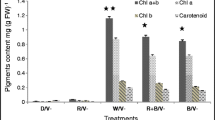Abstract
Under continuous white light (WL), extension growth of the first internode in Sinapis alba L. was promoted by low red (R): far-red (FR) ratios reaching the stem and-or the leaves. Conversely, the growth promotion by end-of-day light treatments was only triggered by FR perceived by the leaves and cotyledons, while FR given to the growning internode alone was tatally ineffective. Continuous WL+FR given to the internode was also in-effective if the rest of the shoot remained in darkness. Both the background stem growth, and the growth promotion caused by either an end-of-day FR pulse or continuous WL+FR given to the internode, increased with increasing fluence rates of WL given to the rest of the shoot. The increase by WL of the growth-stimulatory effect of low phytochrome photoequilibria in the internode appears to be mediated by a specific blue-light-absorbing photoreceptor, as blue-deficient light from sodium-discharge lamps, or from filtered fluorescent tubes, promoted background stem growth similarly to WL but did not amplify the response to the R:FR ratio in the internode. Supplementing the blue-deficient light (94 μmol·m-2·s-1) with low fluence rates of blue (<9 μmol·m-2·s-1) restored the promotive effect of low R:FR reaching the internode.
Similar content being viewed by others
Abbreviations
- BL:
-
blue light
- FR:
-
far-red light
- PAR:
-
photosynthetically active radiation
- Pfr/P:
-
ratio between the FR-absorbing form and total phytochrome
- R:
-
red light
- SOX:
-
low-pressure sodium lamp
- WL:
-
white light
References
Attridge, T.H., Black, M., Gaba, V. (1984) Photocontrol of hypocotyl elongation in light-grown Cucumis sativus. A synergism between the blue-light photoreceptor and phytochrome. Planta 162, 442–426
Ballaré, C.L., Sánchez, R.A., Scopel, A.L., Casal, J.J., Ghersa, C.M. (1987) Early detection of neighbour plants by phytochrome perception of changes in reflected sunlight. Plant Cell Environ. 10, 551–557
Beggs, C.J., Holmes, M.G., Jabben, M., Schäfer, E. (1980) Action spectra for inhibition of hypocotyl growth by continuous irradiation in light and dark grown Sinapis alba L. seedlings. Plant Physiol. 66, 615–618
Black, M., Shuttleworth, J.E. (1974) The role of cotyledons in the photocontrol of hypocotyl extension in Cucumis sativus L. Planta 117, 57–66
Casal, J.J., Smith, H. (1988) Persistent effects of changes in phytochrome status on internode growth in light-grown mustard: Occurrence, kinetics and locus of perception. Planta 175, 214–220
Child, R., Smith, H. (1987) Phytochrome action in light-grown mustard: Kinetics, fluence-rate compensation and ecological significance. Planta 172, 219–229
Downs, J.R., Hendricks, S.B., Borthwick, H.A. (1957) Photoreversible control of elongation of pinto beans and other plants under normal conditions of growth. Bot. Gaz. 118, 199–208
Drumm-Herrel, H., Mohr, H. (1984) Mode of coaction of phytochrome and blue light photoreceptor in control of hypocotyl elongation. Photochem. Photobiol. 40, 261–266
Drumm-Herrel, H., Mohr, H. (1985) Relative importance of blue light and light absorbed by phytochrome in growth of mustard (Sinapis alba L) seedlings. Photochem. Photobiol. 42, 735–739
Gaba, V., Black, M., Attridge, T.H. (1984) Photocontrol of hypocotyl elongation in de-etiolated Cucumis sativus L. Long term, fluence-rate dependent responses to blue light. Plant Physiol. 74, 897–900
García-Martínez, J.L., Keith, B., Bonner, B.A., Stafford, A.E., Rappaport, L. (1987) Phytochrome regulation of the responses to exogenous gibberellins by epicotyls of Vigna sinensis. Plant Physiol. 85, 212–216
Garrison, R., Briggs, W.R. (1975) The growth of internodes in Helianthus in response to far-red light. Bot. Gaz. 136, 353–357
Hayward, P.M. (1984) Determination of phytochrome parameters from radiation measurements. In: Techniques in photomorphogenesis, pp. 159–173, Smith, H., Holmes, M.G., eds. Academic Press, London
Holmes, M.G., Smith, H. (1977) The function of phytochrome in the natural environment. I. Characterisation of daylight for studies in photomorphogenesis and photoperiodism. Photochem. Photobiol. 25, 533–538
Johnson, C.B., Tasker, R. (1979) A scheme to account quantitatively for the action of phytochrome in etiolated and light-grown plants. Plant Cell Environ. 2, 259–265
Jose, A.M., Schäfer, E. (1978) Distorted phytochrome action spectra in green plants. Planta 138, 25–38
Jose, A.M., Schäfer, E. (1980) Rhythmic photoresponses in seedlings of Sinapis alba L. In: Photoreceptors and plant development, pp. 617–626, De Greef, J., ed. Antwerpen Univeristy Press, Belgium
Kleinbaum, D.G., Kupper, L.L. (1978) Applied regression analysis and other multivariate methods. Duxburry Press, North Scituate
Lecharny, A. (1979) Phytochrome and internode elongation in Chenopodium polyspermum L. Site of photoperception. Planta 145, 405–409
Lecharny, A., Jacques, R. (1979) Phytochrome and internode elongation in Chenopodium polyspermum L. The light fluence rate during the day and the end-of-day effect. Planta 146, 575–577
Morgan, D.C., O'Brien, T., Smith, H. (1980) Rapid photomodulation of stem extension in light grown Sinapis alba L.: studies on kinetics, site of perception, and photoreceptor. Planta 150, 95–101
Rich, T.C.G., Whitelam, G.C., Smith, H. (1985) Phototropism and axis extension in light-grown mustard (Sinapis alba L.) seedlings. Photochem. Photobiol. 42, 789–792
Smith, H., Hayward, P. (1985) Fluence rate compensation of the perception of red: far-red ratio by phytochrome in light grown seedlings. Photochem. Photobiol. 42, 685–688
Thomas, B. (1980) The control of hypocotyl extension by blue light. In: Photoreceptors and plant development, pp. 531–535, De Greef, J., ed. Antwerpen-University Press, Belgium
Thomas, B., Dickinson, H.G. (1979) Evidence for two photoreceptors controlling growth in de-etiolated seedlings. Planta 146, 545–550
Wall, J.K., Johnson, C.B. (1981) Phytochrome action in light-grown plants: the influence of light quality and fluence rate on extension growth in Sinapis alba L. Planta 153, 101–108
Wildermann, A., Drumm, H., Schäfer, E., Mohr, H. (1978) Control by light of hypocotyl growth in de-etiolated mustard seedlings. I. Phytochrome as the only photoreceptor pigment. Planta 141, 211–216
Author information
Authors and Affiliations
Additional information
Supported by the Consejo Nacional de Investigaciones Cientificas y Técnicas (República Argentina) and the ORS scheme (UK)
Rights and permissions
About this article
Cite this article
Casal, J.J., Smith, H. The loci of perception for phytochrome control of internode growth in light-grown mustard: Promotion by low phytochrome photoequilibria in the internode is enhanced by blue light perceived by the leaves. Planta 176, 277–282 (1988). https://doi.org/10.1007/BF00392456
Received:
Accepted:
Issue Date:
DOI: https://doi.org/10.1007/BF00392456




